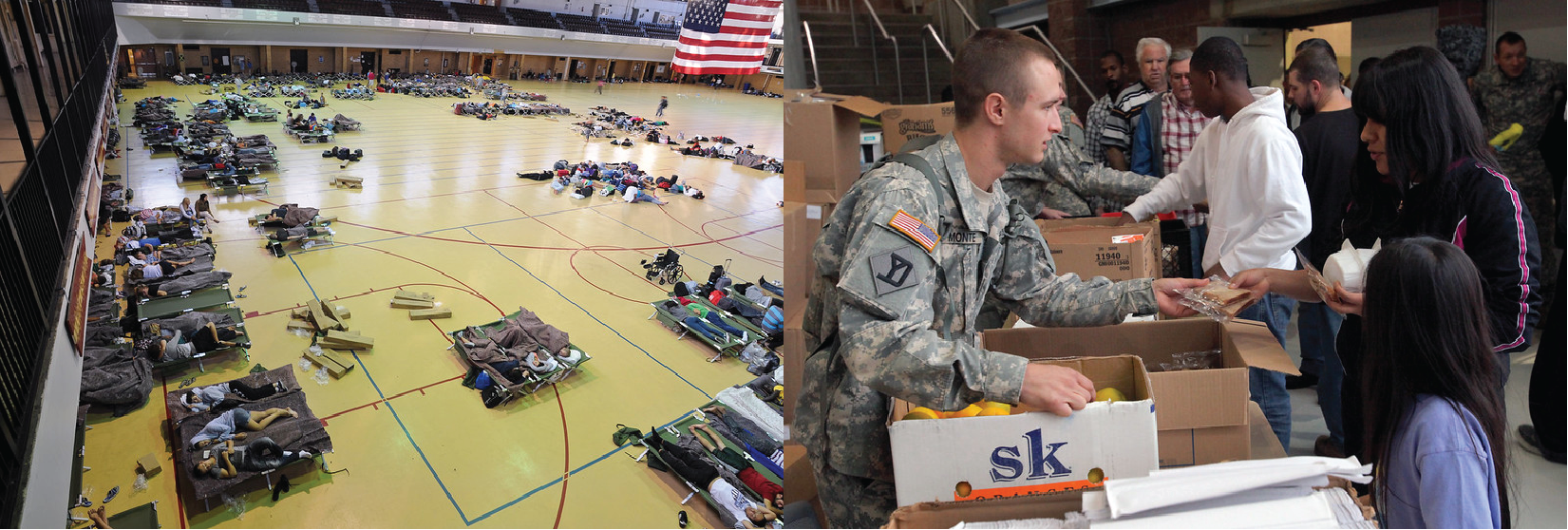Depending on the nature of the chemical incident, people in the affected area may be told to shelter-in-place at a specific location or evacuate the area to prevent them from being exposed and/or contaminated. (Refer to KPF 4, Control the Spread of Contamination for additional information on these protective actions.) Communicating recommended protective actions (e.g., shelter-in-place, proceed with evacuation, etc.) with the public in an efficient and timely manner is essential to protecting life and health. (Refer to KPF 3, Communicate with External Partners and the Public for more information on public information and messaging.)
The requirements for facilities needed during and immediately after a chemical incident to support evacuation and sheltering/temporary housing needs will change depending on the type, scope and scale of the incident – including considerations such as:63
- How many people need to be moved?
- How far do they have to move?
- Are they and/or their service animals/pets contaminated?
- Do they require special medical treatment?
- Do they have a disability?
- How will families be reunified?
A jurisdiction’s sheltering strategy should be layered: for example, if an incident impacts a single city block, the evacuees can be sheltered at congregate shelters or local hotels via existing American Red Cross (ARC) response protocols; for a larger incident, opening dedicated shelters would be required. As with all-hazards disaster events, officials planning for sheltering should prepare to set up shelters to serve disabled individuals and evacuees with animals, and anticipate the potential physical and mental health needs of these individuals. However, even with advance planning, shelter sites may not be fully equipped to address the short-term care needs and placement/disposition for the disabled, dependents (children, the elderly, etc.), and animals of those individuals who become incapacitated due to the chemical incident. In the wake of a chemical incident, equipping shelter facilities to detect, monitor, screen, and decontaminate humans and animals that were not decontaminated at the primary event location should be a serious consideration; this is discussed further in Section 1.5.
In the immediate aftermath of a chemical incident, transportation services may be needed to evacuate people and animals from the incident site and/or at-risk areas to mass care or health care facilities or areas of safety. Answers to the above questions will also dictate the types of transportation resources required to support evacuation, such as buses, paratransit, ambulances, etc.
1.2.1. Types of Evacuation Facilities
Different types of evacuation facilities may be needed during and after a chemical incident, depending on the scale of the incident.63
- Evacuation Assembly Points are temporary locations set up for evacuation embarkation and transportation coordination; other services are generally not available.
- Emergency Respite Sites are locations along an evacuation route that can support transportation-assisted evacuees and self-evacuees. Respite sites may include fuel stations, restroom facilities, and access to water.
- Regional Hub Reception Centers (RHRCs) are facilities where evacuees can receive assistance in identifying the most appropriate shelter location for their needs. RHRCs are typically state-run and employed during large-scale, multi-jurisdictional events.
- Emergency shelters assist in providing immediate lifesaving and sustaining care until conditions stabilize and full services can be established at shelter locations; they generally have limited supplies and services.
- Shelters (mass care) are facilities where evacuees receive disaster services from government agencies and/or pre-established volunteer organizations. Meals and water are available, as well as basic first aid, pet and service animal sheltering, sleeping quarters, and hygienic support, and basic disaster services (e.g., counseling, financial assistance, referrals) should be available. (Note, “shelter” refers to a fully functional evacuation shelter.)

Footnotes
63. Department of Homeland Security. (2019, July). Planning Considerations: Evacuation and Shelter-in-Place Guidance for State, Local, Tribal, and Territorial Partners.

